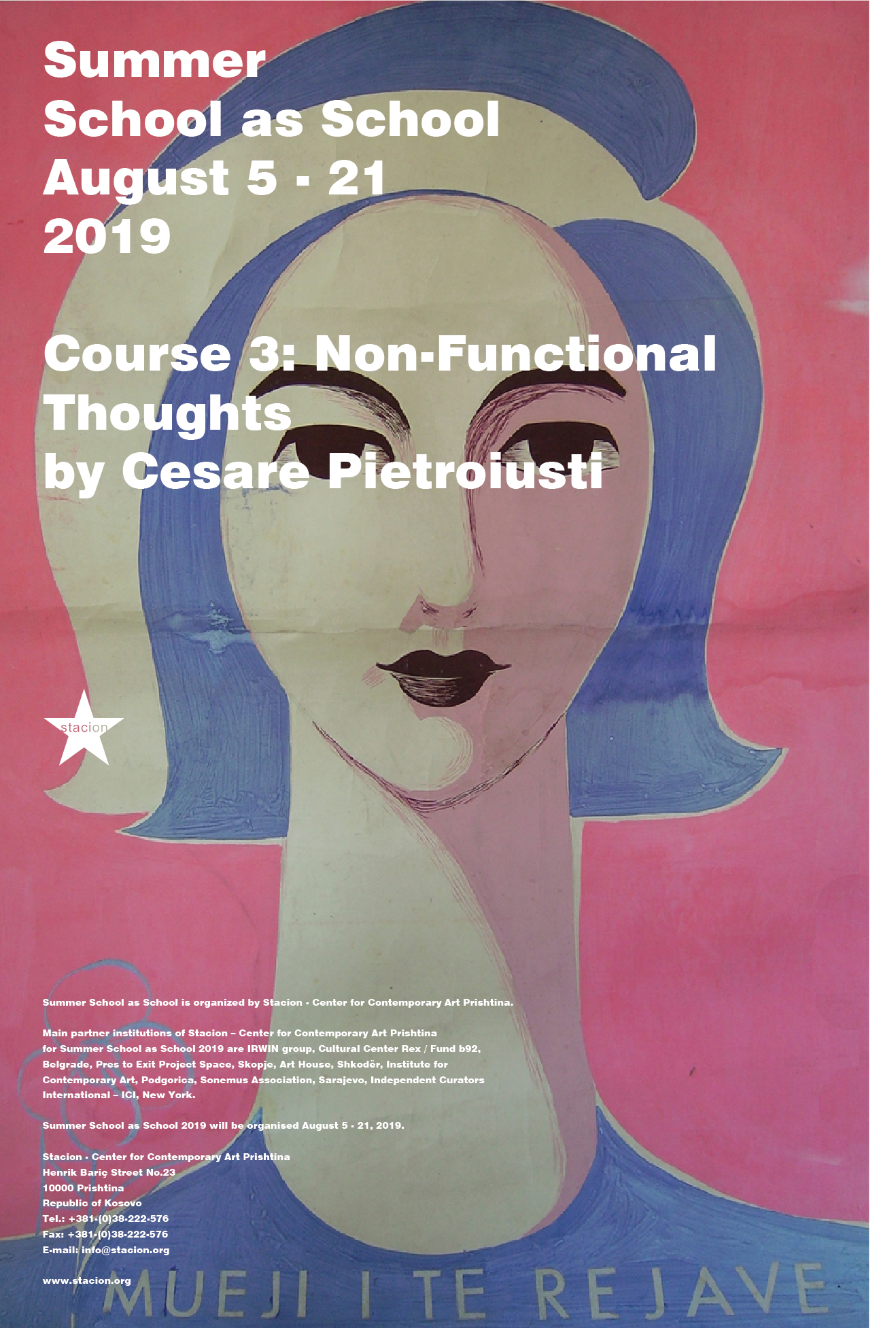
Course 3: Non-Functional Thoughts
by Cesare Pietroiusti
5 – 7 August, 2019
Course Description
Non-functional thought can be relative to one’s own situation; it can be a way of observing fragments of reality, of creating connections between events, people, places, perceptions, beliefs, etc. Each idea that is not directly determined by carrying out an activity, and therefore appears to be without a reason, can be considered non-functional.
This impractical idea, even if superfluous, is lived in a non-compulsory and non-neurotic manner. It is an apparition whose appearance cannot be predicted, and whose purpose is not clear. The territory of the non-functional thought does not belong exclusively to a specific category of people (e.g. artists or psychopaths), but is shared by everyone. In the majority of cases, however, such thoughts are excluded or ignored because they are parasitically disturbing the mechanisms of mental concentration commonly applied to such tasks as working or studying.
Non-functional thoughts can appear in any situation, even if they tend to manifest when our attention is not engaged. They arise when the external and internal perceptive data are not strongly ordered by some sort of goal, such as during a long wait, or a lonely car journey. The persistence of thoughts of such a kind in individual memory is very rare. If they are not fixed by writing or other means, they tend to disappear in a short time. This process of erasure operates in a similar manner to what happens during the forgetting of dreams. One of the central ideas behind my work is that it is possible to make an artwork that concentrates attention on non-functional thoughts. My practice is an attempt to better articulate these thoughts by building a communicative context in which they can be recognized by others as part of a shared patrimony.
This impractical idea, even if superfluous, is lived in a non-compulsory and non-neurotic manner. It is an apparition whose appearance cannot be predicted, and whose purpose is not clear. The territory of the non-functional thought does not belong exclusively to a specific category of people (e.g. artists or psychopaths), but is shared by everyone. In the majority of cases, however, such thoughts are excluded or ignored because they are parasitically disturbing the mechanisms of mental concentration commonly applied to such tasks as working or studying.
Non-functional thoughts can appear in any situation, even if they tend to manifest when our attention is not engaged. They arise when the external and internal perceptive data are not strongly ordered by some sort of goal, such as during a long wait, or a lonely car journey. The persistence of thoughts of such a kind in individual memory is very rare. If they are not fixed by writing or other means, they tend to disappear in a short time. This process of erasure operates in a similar manner to what happens during the forgetting of dreams. One of the central ideas behind my work is that it is possible to make an artwork that concentrates attention on non-functional thoughts. My practice is an attempt to better articulate these thoughts by building a communicative context in which they can be recognized by others as part of a shared patrimony.
At best, this investigation points to the possible existence of a psychic dimension that is generally ignored. Non-functional thoughts can retain the form of a ‘project’ that, through various technical choices, and in different circumstances, can become an element of communication and of socialization. The participants will be invited to formulate, elaborate and use some of their own non-functional thoughts.
Biography
Cesare Pietroiusti is an artist living in Rome, principally concerned with problematic and paradoxical situations that are hidden in common relationships and ordinary acts. In particular, through performative actions his practice explores the relations between the logics of economy, exchange and art’s perceived worth. Trained as a medical doctor, Pietroiusti studied Psychiatry in the late 1970s. His artist’s book Pensieri non-funzionali (1997) - Non Functional Thoughts (2000) documents many of his projects, both realized and un-realized (www.nonfunctionalthoughts.net). Either singularly or as a member of collectives, Pietroiusti participated in group and solo exhibitions since 1977, including “Exhibit A” (Serpentine Gallery, London, 1992); “NowHere” (Louisiana Museum, Humlebæk, 1996); Venice Biennale (1990, 1999, 2003); Tirana Biennale (2005), Performa 07, New York (2007) and the Athens Biennale (2009). Solo projects were held at Jartrakor, Rome (1978, 1980, 1983, 1984, 1985), Studio Casoli, Milano (1987), Galleria Alice, Rome (1989); Galleria Primo Piano, Rome (1994); Ikon Gallery, Birmingham (2007); MaMbo, Bologna (2008, with Stefano Arienti); Galleria Franco Soffiantino, Torino (2009); and Wilkinson Gallery, London (2009). Pietroiusti has been a professor of studio practice at the University of Venice (IUAV) from 2004 to 2015 and MFA faculty professor at The Art Institute of Boston (2009-2016), as well as curator at the Fondazione Ratti residency program in Como (2007-2011). Co-founder of many artist-run projects including the experimental space Jartrakor in Rome (1977-1985), Gruppo di Piombino (1986-1992), Giochi del Senso e/o Nonsenso (1996), Oreste (1997-2001), Nomads and Residents in New York (2000-2001) ,Trastevere 259 (2006-2011), and Museo dell’Arte Italiana in Esilio (2010-2011), Lu Cafausu (2007-ongoing), Pietroiusti is one of the founders of Fondazione Lac o Le Mon (2015-ongoing), an old house in southern Italy that has become a space for artistic research and experimental and interdisciplinary pedagogy.
Participation
10 participants will be selected to participate in this course. Eligible participants must read the Terms, fill out the application form, upload the required documents and submit the application form. Incomplete applications will not be considered.
Scholarships are available for participants from Kosovo.
A limited number of scholarships, that cover the participation fee, are available for international participants.